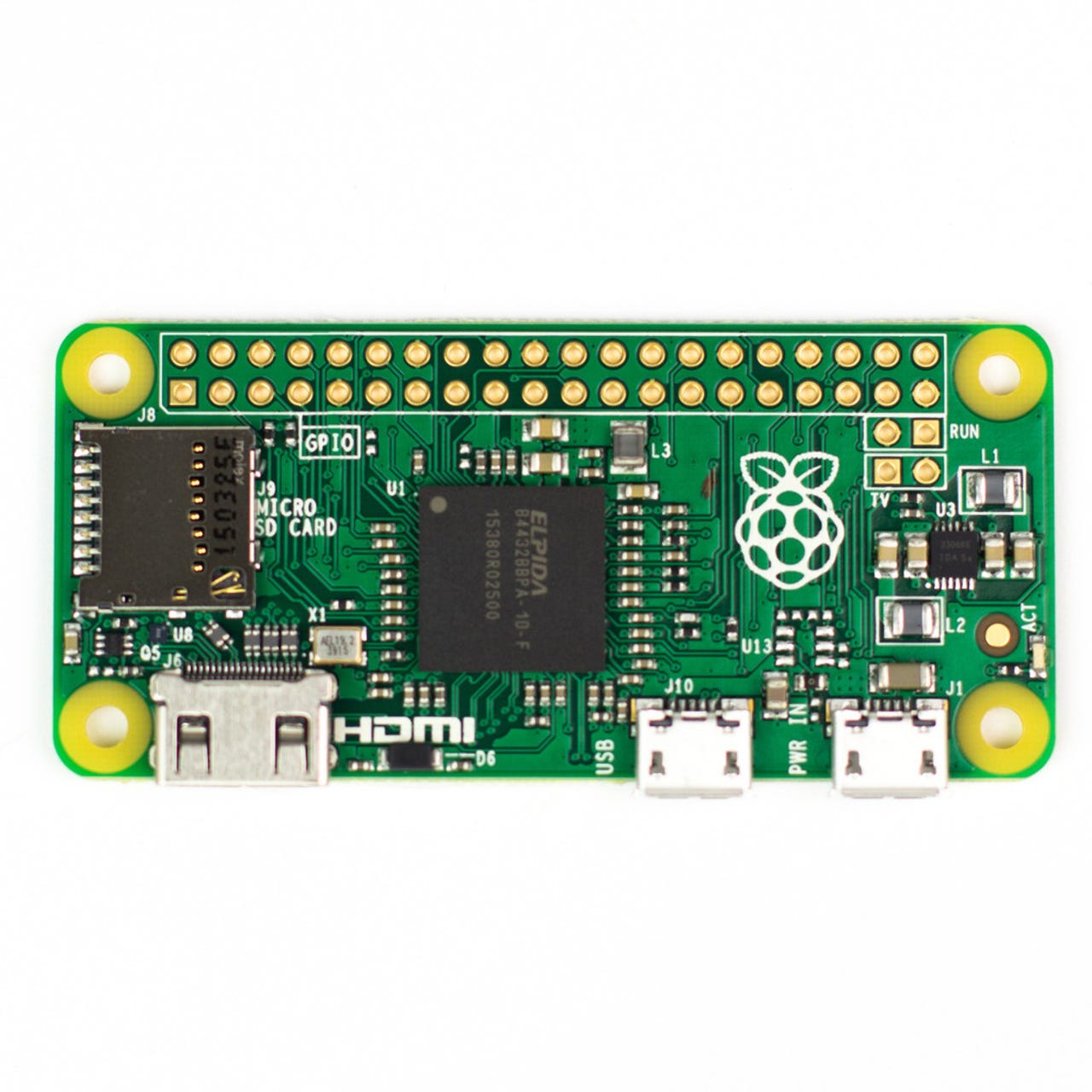Photos of the Raspberry Pi through the ages: From the prototype to Pi 3 B+

2006 - $25 computer prototype
More than eight million Raspberry Pi computers have shipped since the product launched four years ago.
The popularity of the $35 machine for hacking together software and hardware, or just for using as a budget PC, even took the creators by surprise.
This gallery shows every version of the Raspberry Pi released to date, including the Raspberry Pi 3, which launched this morning.
This image is of a prototype of a $25 computer put together by the Raspberry Pi's co-creator Eben Upton in 2006.
The board uses an Atmel ATmega644 microcontroller clocked at 22.1MHz, and a 512K SRAM. Nineteen of the Atmel's 32 general-purpose input/output pin lines are used to drive the SRAM address bus. The board could output a 320×240 resolution image to a display.
February 2012 - Raspberry Pi 1 Model B
The first Pi to be introduced - the credit card-sized board made an impression for being a usable Linux computer that cost just $35.
Specs
- Broadcom BCM2835 700MHz ARM1176JZFS processor with FPU and Videocore 4 GPU
- GPU provides Open GL ES 2.0, hardware-accelerated OpenVG, and 1080p3D
- H.264 high-profile decode GPU is capable of 1Gpixel/s, 1.5Gtexel/s or 24GFLOPs with texture filtering and DMA infrastructure
- 256MB RAM (later upgraded to 512MB)
- Boots from SD card
- 10/100-BaseT Ethernet port
- HDMI port
- Two USB 2.0 port
- RCA video port
- SD card slot
- Powered from microUSB port
- 3.5mm audio out jack
- Header footprint for camera connection
- Size: 85.6 x 53.98 x 17mm
February 2013 - Raspberry Pi 1 Model A
The lower specced variant of the Raspberry Pi - which sells for a cheaper price but has less memory, only one USB port and no Ethernet. Popular for use in embedded projects.
Specs
- Broadcom BCM2835 700MHz ARM1176JZFS processor with FPU and Videocore 4 GPU
- GPU provides Open GL ES 2.0, hardware-accelerated OpenVG, and 1080p3D
- H.264 high-profile decode GPU is capable of 1Gpixel/s, 1.5Gtexel/s or 24GFLOPs with texture filtering and DMA infrastructure.
- 256MB RAM
- Boots from SD card
- HDMI port
- One USB 2.0 port
- RCA video port
- SD card slot
- Powered from microUSB port
- 3.5mm audio out jack
- Header footprint for camera connection
- Size: 85.6 x 53.98 x 17mm
April 2014 - Raspberry Pi Compute Module
The guts of a Raspberry Pi shrunk down to fit on a board the size of a memory module - aimed at those who want to create prototype electronics.
The compute board has the same ARM-based Broadcom 2835 chip as the Raspberry Pi 1 and 512MB of SDRAM, together with 4GB of eMMC flash storage. The module is a 200-pin board based on the Jedec SODIMM form factor.
July 2014 - Raspberry Pi 1 Model B+
A souped-up version of the original Raspberry Pi Model B board - adding more power, more USB ports, more general-purpose input/output pins to expand the board, a tidied-up layout and better audio.
Specs
Chip: Broadcom BCM2835 SoCCore architecture: ARM11CPU: 700 MHz Low Power ARM1176JZFS Applications Processor
GPU: Dual Core VideoCore IV® Multimedia Co-Processor. Provides Open GL ES 2.0, hardware-accelerated OpenVG, and 1080p30 H.264 high-profile decode. Capable of 1Gpixel/s, 1.5Gtexel/s or 24GFLOPs with texture filtering and DMA infrastructure.
Memory: 512MB SDRAM
Operating System: Boots from Micro SD card, running a version of the Linux operating system. A range of Linux-based OSes are available to download, including NOOBS, Raspbian, Pidora, OpenELEC, RaspBMC. Also available is Risc OS, a non-Linux distro.
Power: Micro USB socket 5V, 2A
Ethernet: 10/100 BaseT
Video Output: HDMI (rev 1.3 & 1.4), Composite RCA (PAL and NTSC)
Audio Output: 3.5mm jack, HDMI
USB: 4 x USB 2.0 Connector.
GPIO: Connector 40-pin 2.54 mm (100 mil) expansion header: 2x20 strip. Providing 27 GPIO pins as well as +3.3 V, +5 V and GND supply lines
Camera: Connector 15-pin MIPI Camera Serial Interface (CSI-2)
JTAG: Not populated
Display Connector: Display Serial Interface (DSI) 15 way flat flex cable connector with two data lanes and a clock lane
Memory Card Slot: SDIO
Dimensions: 85 x 56 x 17mm
November 2014 - Raspberry Pi 1 Model A+
An even smaller version of the Raspberry Pi 1 Model A, which consumes less power, has more general-purpose input/output pins for expandability, uses Micro SD rather than SD and offers better audio.
Specs
Chip: Broadcom BCM2835 SoC
Core: architecture ARM11
CPU: 700 MHz Low Power ARM1176JZFS Applications Processor
GPU: Dual Core VideoCore IV Multimedia Co-Processor. Provides Open GL ES 2.0, hardware-accelerated OpenVG, and 1080p30 H.264 high-profile decode. Capable of 1Gpixel/s, 1.5Gtexel/s or 24GFLOPs with texture filtering and DMA infrastructure.
Memory: 256MB SDRAM
Dimensions: 65mm x 56mm / 2.5" x 2.25"
Power: Micro USB socket 5V, 2A
No Ethernet
Audio Output: 3.5mm jack, HDMI
USB: 1 x USB 2.0 Connector
GPIO: Connector 40-pin 2.54 mm (100 mil) expansion header: 2x20 strip. Providing 27 GPIO pins as well as +3.3 V, +5 V and GND supply lines
Video Output: HDMI and Composite
Sound: L/R Stereo (via 3.5mm 4 Pole Cable)
Memory: 256MB Ram
Operating System: Uses microSD card slot to load OS. A range of Linux-based OSes are available to download, including NOOBS, Raspbian, Pidora, OpenELEC, RaspBMC. Also available is RiscOS, a non-Linux distro.
Digital interfaces: 2 onboard ribbon slots for Camera and Display
February 2015 - Raspberry Pi 2 Model B
The Raspberry Pi 2 boosted the board's specs to a quad-core processor and 1GB of memory - with the new machine racking up several times the benchmark score of its predecessor, as well as being able to run Windows 10 IoT Core and Ubuntu.
Specs
- 900MHz quad-core Broadcom BCM2836 CPU with 1GB DDR2 RAM
- VideoCore IV 3D graphics core
- 40 pin extended pins - with 27 GPIO pins
- Micro SD slot
- Multiple ports: Four USB ports, full sized HDMI, four pole stereo output and composite video port. CSI camera port and DSI display port
- 10/100 BaseT Ethernet
- Micro-USB power source 5V, 2A
- Dimensions: 85 x 56 x 17mm

November 2015 - Raspberry Pi Zero
Despite costing a minuscule $5, the Pi Zero is a little bit more capable than the original Raspberry Pi Model B that launched back in 2012 for $35.
The board has the same single-core, ARM-based processor as the first gen Model B but it's slightly faster. The system memory remains the same.
Specs
- BCM 2835 System on a Chip 1GHz
- 512MB of RAM
- micro-SD storage
- mini-HDMI
- Two micro USB ports - one for power and one for data
- Unpopulated 40-pin GPIO connector
- Compatible with existing HAT addons
- Dimensions: 65mm x 30mm x 5mm
February 2016 - Raspberry Pi 3 Model B
The Raspberry Pi 3 introduces support for a number of technologies for the first time. It's the first Pi to be based on a 64-bit chipset and to include wi-fi and Bluetooth connectivity.
The newer and faster chipset performs some 50 percent better than that of the Raspberry Pi 2 and roughly ten times better than the original single-core Raspberry Pi in a multi-threaded CPU benchmark like SysBench.
Specs
- Chipset: Broadcom BCM2837
- CPU: 1.2GHz quad-core 64-bit ARM cortex A53
- Ethernet : 10/100 (Max throughput 100Mbps)
- USB: Four USB 2.0 with 480Mbps data transfer
- Storage: MicroSD card or via USB-attached storage
- Wireless: 802.11n Wireless LAN (Peak transmit/receive throughput of 150Mbps), Bluetooth 4.1
- Graphics: 400MHz VideoCore IV multimedia
- Memory: 1GB LPDDR2-900 SDRAM
- Expandability: 40 general purpose input-output pins
- Video: Full HDMI port
- Audio: Combined 3.5mm audio out jack and composite video
- Camera interface (CSI)
- Display interface (DSI)
March 2018 - Raspberry Pi 3 Model B+
The new Raspberry Pi 3 Model B+ is the most powerful Raspberry Pi available, upping both the raw performance and Wi-Fi speeds.
The new board is a beefier version of the Raspberry Pi 3 Model B, sharing many of the same specs but overclocking the processor to 1.4GHz -- a 16.7% increase.
On top of the faster processor, the new board also boasts improved connectivity, adding support for dual-band 802.11b/g/n/ac Wi-Fi -- effectively almost tripling the Wi-Fi throughput of the base Pi 3 -- and increasing the speed of the board's Ethernet.
Specs
Processor: Broadcom BCM2837B0, quad-core A53 (ARMv8) 64-bit SoC @1.4GHz
Memory: 1GB LPDDR2 SDRAM
Connectivity: 2.4GHz and 5GHz IEEE 802.11 b/g/n/ac wireless LAN, Bluetooth 4.2, BLE. Gigabit Ethernet over USB 2.0 (maximum throughput of 300Mbps).
USB: 4 x 2.0
Expandability: Extended 40-pin GPIO header
Video and sound: 1 x full-sized HDMI port, MIPI DSI display port, MIPI CSI camera port, 4 pole stereo output and composite video port.
Multimedia: H.264, MPEG-4 decode (1080p30), H.264 encode (1080p30); OpenGL ES 1.1, 2.0 graphics
SD card support: microSD format for OS and data storage
Input power: 5V/2.5A DC via microUSB connector, 5V DC via GPIO header, Power over Ethernet (PoE)-enabled (requires separate PoE add-on).
Environment: Operating temperature 0 - 50C
Compliance: Local and regional approvals listed here.
Production lifetime: Raspberry Pi 3 Model B+ will remain in production until at least January 2023.